CHCECE020 Assessment 2: Biting Behavior Plan for Toddler
VerifiedAdded on 2023/05/28
|5
|2214
|361
Homework Assignment
AI Summary
This assignment presents a student's analysis of a biting behavior plan for a 3.5-year-old child in a childcare setting. The analysis begins with an assessment of the child's baseline behavior, noting her typical calm and cooperative demeanor, as well as her active participation in daily routines. The student identifies biting as the behavior of concern, exploring potential triggers such as the child's developmental stage and difficulty expressing feelings, and the impact on other children. The assignment outlines current strategies, including educator interventions and communication with parents, along with short-term and long-term objectives. The student evaluates the effectiveness of the plan, suggests improvements, and discusses how the plan aligns with the National Quality Framework and the Early Years Learning Framework. Finally, the student reflects on how they supported colleagues and would have handled the situation differently if not directly involved.
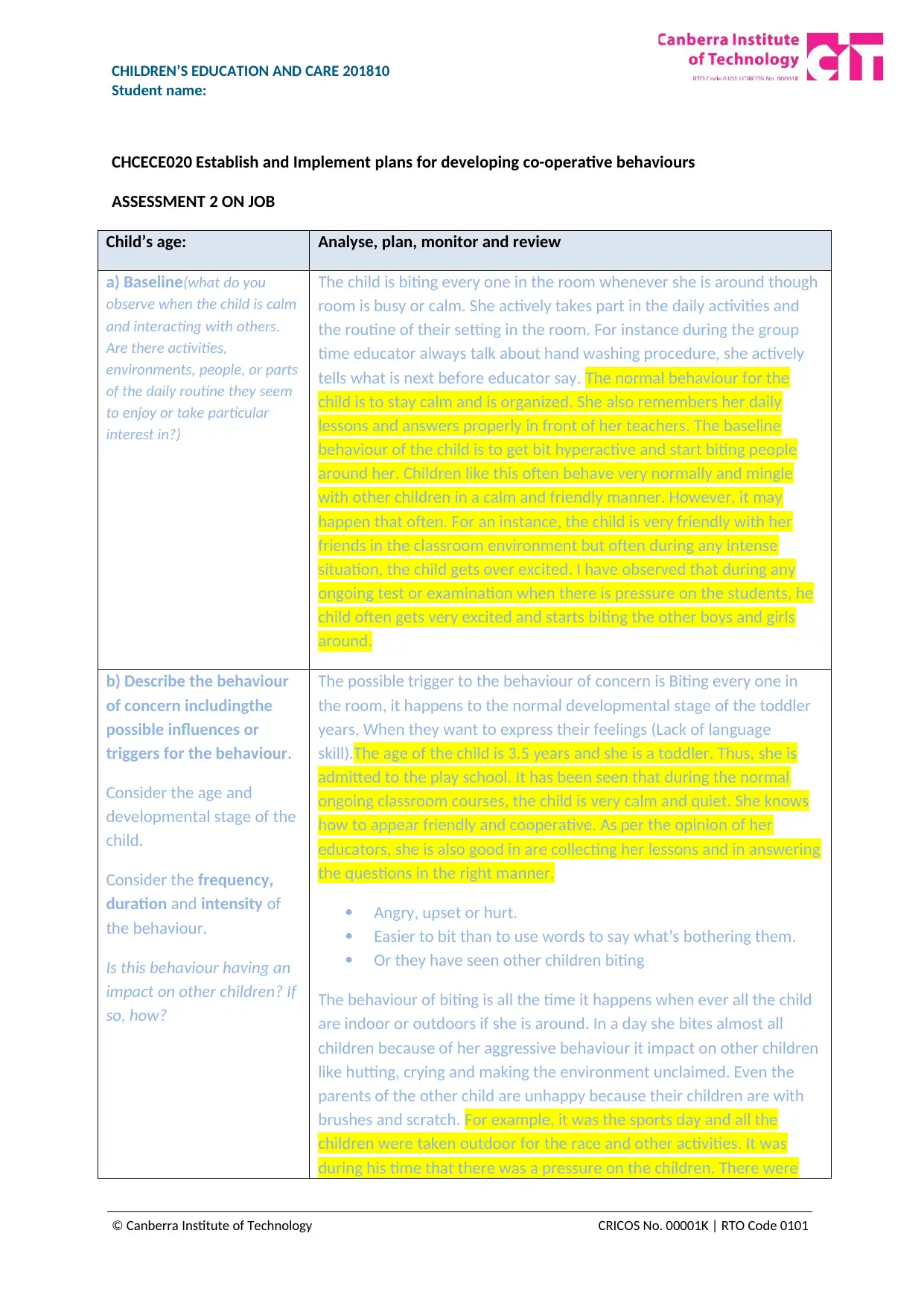
CHILDREN’S EDUCATION AND CARE 201810
Student name:
CHCECE020 Establish and Implement plans for developing co-operative behaviours
ASSESSMENT 2 ON JOB
Child’s age: Analyse, plan, monitor and review
a) Baseline(what do you
observe when the child is calm
and interacting with others.
Are there activities,
environments, people, or parts
of the daily routine they seem
to enjoy or take particular
interest in?)
The child is biting every one in the room whenever she is around though
room is busy or calm. She actively takes part in the daily activities and
the routine of their setting in the room. For instance during the group
time educator always talk about hand washing procedure, she actively
tells what is next before educator say. The normal behaviour for the
child is to stay calm and is organized. She also remembers her daily
lessons and answers properly in front of her teachers. The baseline
behaviour of the child is to get bit hyperactive and start biting people
around her. Children like this often behave very normally and mingle
with other children in a calm and friendly manner. However, it may
happen that often. For an instance, the child is very friendly with her
friends in the classroom environment but often during any intense
situation, the child gets over excited. I have observed that during any
ongoing test or examination when there is pressure on the students, he
child often gets very excited and starts biting the other boys and girls
around.
b) Describe the behaviour
of concern includingthe
possible influences or
triggers for the behaviour.
Consider the age and
developmental stage of the
child.
Consider the frequency,
duration and intensity of
the behaviour.
Is this behaviour having an
impact on other children? If
so, how?
The possible trigger to the behaviour of concern is Biting every one in
the room, it happens to the normal developmental stage of the toddler
years, When they want to express their feelings (Lack of language
skill).The age of the child is 3.5 years and she is a toddler. Thus, she is
admitted to the play school. It has been seen that during the normal
ongoing classroom courses, the child is very calm and quiet. She knows
how to appear friendly and cooperative. As per the opinion of her
educators, she is also good in are collecting her lessons and in answering
the questions in the right manner.
Angry, upset or hurt.
Easier to bit than to use words to say what’s bothering them.
Or they have seen other children biting
The behaviour of biting is all the time it happens when ever all the child
are indoor or outdoors if she is around. In a day she bites almost all
children because of her aggressive behaviour it impact on other children
like hutting, crying and making the environment unclaimed. Even the
parents of the other child are unhappy because their children are with
brushes and scratch. For example, it was the sports day and all the
children were taken outdoor for the race and other activities. It was
during his time that there was a pressure on the children. There were
© Canberra Institute of Technology CRICOS No. 00001K | RTO Code 0101
Student name:
CHCECE020 Establish and Implement plans for developing co-operative behaviours
ASSESSMENT 2 ON JOB
Child’s age: Analyse, plan, monitor and review
a) Baseline(what do you
observe when the child is calm
and interacting with others.
Are there activities,
environments, people, or parts
of the daily routine they seem
to enjoy or take particular
interest in?)
The child is biting every one in the room whenever she is around though
room is busy or calm. She actively takes part in the daily activities and
the routine of their setting in the room. For instance during the group
time educator always talk about hand washing procedure, she actively
tells what is next before educator say. The normal behaviour for the
child is to stay calm and is organized. She also remembers her daily
lessons and answers properly in front of her teachers. The baseline
behaviour of the child is to get bit hyperactive and start biting people
around her. Children like this often behave very normally and mingle
with other children in a calm and friendly manner. However, it may
happen that often. For an instance, the child is very friendly with her
friends in the classroom environment but often during any intense
situation, the child gets over excited. I have observed that during any
ongoing test or examination when there is pressure on the students, he
child often gets very excited and starts biting the other boys and girls
around.
b) Describe the behaviour
of concern includingthe
possible influences or
triggers for the behaviour.
Consider the age and
developmental stage of the
child.
Consider the frequency,
duration and intensity of
the behaviour.
Is this behaviour having an
impact on other children? If
so, how?
The possible trigger to the behaviour of concern is Biting every one in
the room, it happens to the normal developmental stage of the toddler
years, When they want to express their feelings (Lack of language
skill).The age of the child is 3.5 years and she is a toddler. Thus, she is
admitted to the play school. It has been seen that during the normal
ongoing classroom courses, the child is very calm and quiet. She knows
how to appear friendly and cooperative. As per the opinion of her
educators, she is also good in are collecting her lessons and in answering
the questions in the right manner.
Angry, upset or hurt.
Easier to bit than to use words to say what’s bothering them.
Or they have seen other children biting
The behaviour of biting is all the time it happens when ever all the child
are indoor or outdoors if she is around. In a day she bites almost all
children because of her aggressive behaviour it impact on other children
like hutting, crying and making the environment unclaimed. Even the
parents of the other child are unhappy because their children are with
brushes and scratch. For example, it was the sports day and all the
children were taken outdoor for the race and other activities. It was
during his time that there was a pressure on the children. There were
© Canberra Institute of Technology CRICOS No. 00001K | RTO Code 0101
Secure Best Marks with AI Grader
Need help grading? Try our AI Grader for instant feedback on your assignments.
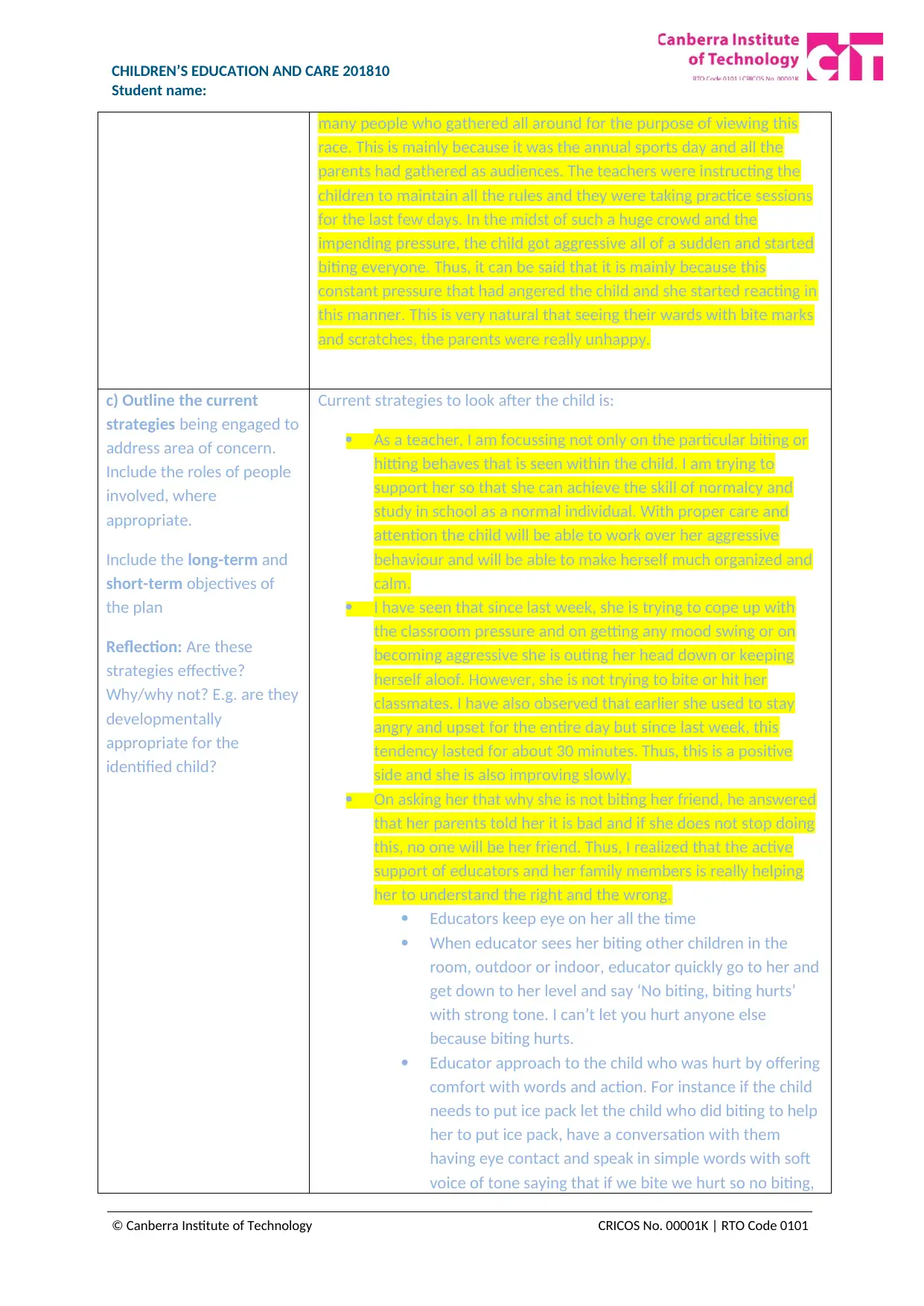
CHILDREN’S EDUCATION AND CARE 201810
Student name:
many people who gathered all around for the purpose of viewing this
race. This is mainly because it was the annual sports day and all the
parents had gathered as audiences. The teachers were instructing the
children to maintain all the rules and they were taking practice sessions
for the last few days. In the midst of such a huge crowd and the
impending pressure, the child got aggressive all of a sudden and started
biting everyone. Thus, it can be said that it is mainly because this
constant pressure that had angered the child and she started reacting in
this manner. This is very natural that seeing their wards with bite marks
and scratches, the parents were really unhappy.
c) Outline the current
strategies being engaged to
address area of concern.
Include the roles of people
involved, where
appropriate.
Include the long-term and
short-term objectives of
the plan
Reflection: Are these
strategies effective?
Why/why not? E.g. are they
developmentally
appropriate for the
identified child?
Current strategies to look after the child is:
As a teacher, I am focussing not only on the particular biting or
hitting behaves that is seen within the child. I am trying to
support her so that she can achieve the skill of normalcy and
study in school as a normal individual. With proper care and
attention the child will be able to work over her aggressive
behaviour and will be able to make herself much organized and
calm.
I have seen that since last week, she is trying to cope up with
the classroom pressure and on getting any mood swing or on
becoming aggressive she is outing her head down or keeping
herself aloof. However, she is not trying to bite or hit her
classmates. I have also observed that earlier she used to stay
angry and upset for the entire day but since last week, this
tendency lasted for about 30 minutes. Thus, this is a positive
side and she is also improving slowly.
On asking her that why she is not biting her friend, he answered
that her parents told her it is bad and if she does not stop doing
this, no one will be her friend. Thus, I realized that the active
support of educators and her family members is really helping
her to understand the right and the wrong.
Educators keep eye on her all the time
When educator sees her biting other children in the
room, outdoor or indoor, educator quickly go to her and
get down to her level and say ‘No biting, biting hurts’
with strong tone. I can’t let you hurt anyone else
because biting hurts.
Educator approach to the child who was hurt by offering
comfort with words and action. For instance if the child
needs to put ice pack let the child who did biting to help
her to put ice pack, have a conversation with them
having eye contact and speak in simple words with soft
voice of tone saying that if we bite we hurt so no biting,
© Canberra Institute of Technology CRICOS No. 00001K | RTO Code 0101
Student name:
many people who gathered all around for the purpose of viewing this
race. This is mainly because it was the annual sports day and all the
parents had gathered as audiences. The teachers were instructing the
children to maintain all the rules and they were taking practice sessions
for the last few days. In the midst of such a huge crowd and the
impending pressure, the child got aggressive all of a sudden and started
biting everyone. Thus, it can be said that it is mainly because this
constant pressure that had angered the child and she started reacting in
this manner. This is very natural that seeing their wards with bite marks
and scratches, the parents were really unhappy.
c) Outline the current
strategies being engaged to
address area of concern.
Include the roles of people
involved, where
appropriate.
Include the long-term and
short-term objectives of
the plan
Reflection: Are these
strategies effective?
Why/why not? E.g. are they
developmentally
appropriate for the
identified child?
Current strategies to look after the child is:
As a teacher, I am focussing not only on the particular biting or
hitting behaves that is seen within the child. I am trying to
support her so that she can achieve the skill of normalcy and
study in school as a normal individual. With proper care and
attention the child will be able to work over her aggressive
behaviour and will be able to make herself much organized and
calm.
I have seen that since last week, she is trying to cope up with
the classroom pressure and on getting any mood swing or on
becoming aggressive she is outing her head down or keeping
herself aloof. However, she is not trying to bite or hit her
classmates. I have also observed that earlier she used to stay
angry and upset for the entire day but since last week, this
tendency lasted for about 30 minutes. Thus, this is a positive
side and she is also improving slowly.
On asking her that why she is not biting her friend, he answered
that her parents told her it is bad and if she does not stop doing
this, no one will be her friend. Thus, I realized that the active
support of educators and her family members is really helping
her to understand the right and the wrong.
Educators keep eye on her all the time
When educator sees her biting other children in the
room, outdoor or indoor, educator quickly go to her and
get down to her level and say ‘No biting, biting hurts’
with strong tone. I can’t let you hurt anyone else
because biting hurts.
Educator approach to the child who was hurt by offering
comfort with words and action. For instance if the child
needs to put ice pack let the child who did biting to help
her to put ice pack, have a conversation with them
having eye contact and speak in simple words with soft
voice of tone saying that if we bite we hurt so no biting,
© Canberra Institute of Technology CRICOS No. 00001K | RTO Code 0101
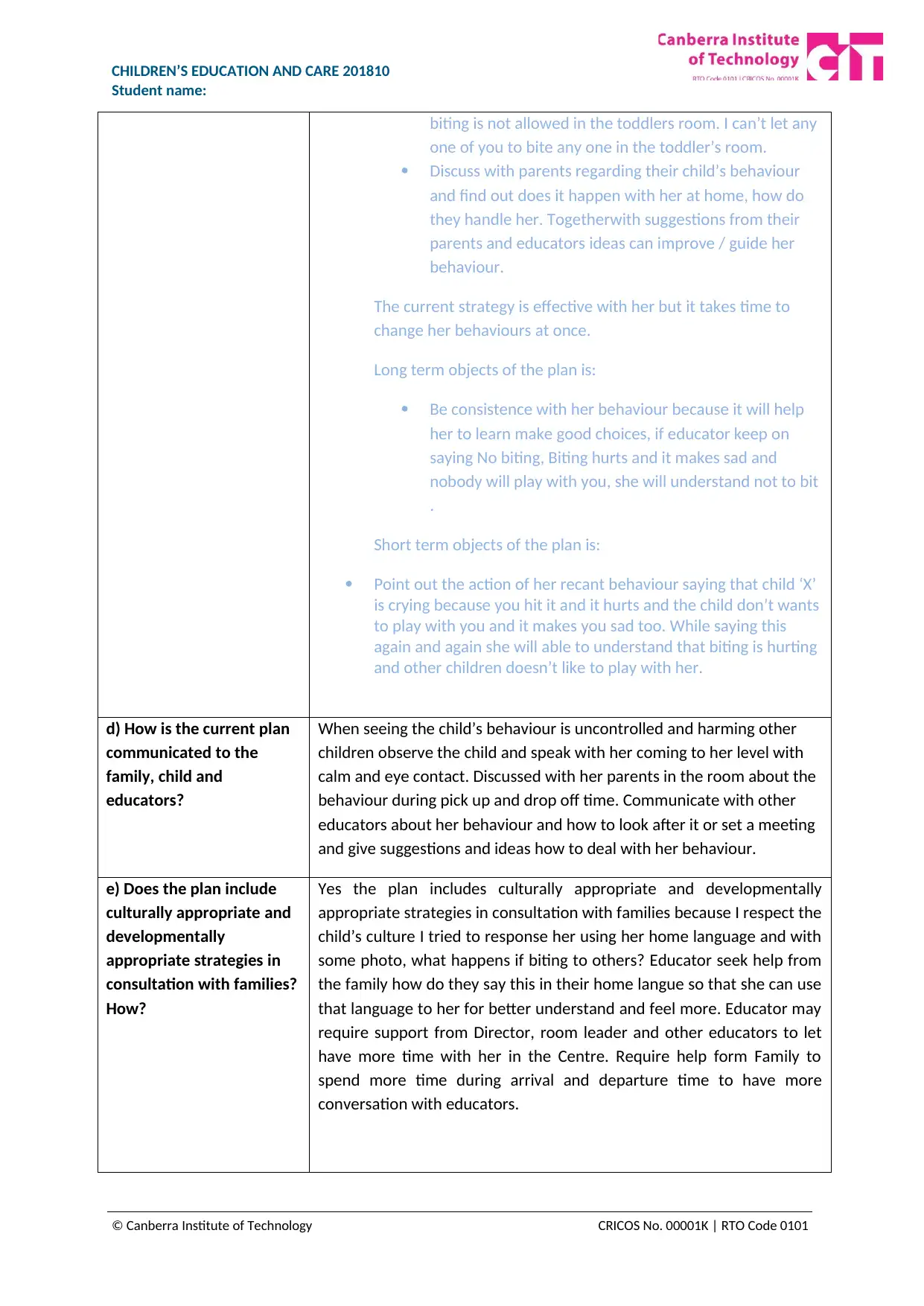
CHILDREN’S EDUCATION AND CARE 201810
Student name:
biting is not allowed in the toddlers room. I can’t let any
one of you to bite any one in the toddler’s room.
Discuss with parents regarding their child’s behaviour
and find out does it happen with her at home, how do
they handle her. Togetherwith suggestions from their
parents and educators ideas can improve / guide her
behaviour.
The current strategy is effective with her but it takes time to
change her behaviours at once.
Long term objects of the plan is:
Be consistence with her behaviour because it will help
her to learn make good choices, if educator keep on
saying No biting, Biting hurts and it makes sad and
nobody will play with you, she will understand not to bit
.
Short term objects of the plan is:
Point out the action of her recant behaviour saying that child ‘X’
is crying because you hit it and it hurts and the child don’t wants
to play with you and it makes you sad too. While saying this
again and again she will able to understand that biting is hurting
and other children doesn’t like to play with her.
d) How is the current plan
communicated to the
family, child and
educators?
When seeing the child’s behaviour is uncontrolled and harming other
children observe the child and speak with her coming to her level with
calm and eye contact. Discussed with her parents in the room about the
behaviour during pick up and drop off time. Communicate with other
educators about her behaviour and how to look after it or set a meeting
and give suggestions and ideas how to deal with her behaviour.
e) Does the plan include
culturally appropriate and
developmentally
appropriate strategies in
consultation with families?
How?
Yes the plan includes culturally appropriate and developmentally
appropriate strategies in consultation with families because I respect the
child’s culture I tried to response her using her home language and with
some photo, what happens if biting to others? Educator seek help from
the family how do they say this in their home langue so that she can use
that language to her for better understand and feel more. Educator may
require support from Director, room leader and other educators to let
have more time with her in the Centre. Require help form Family to
spend more time during arrival and departure time to have more
conversation with educators.
© Canberra Institute of Technology CRICOS No. 00001K | RTO Code 0101
Student name:
biting is not allowed in the toddlers room. I can’t let any
one of you to bite any one in the toddler’s room.
Discuss with parents regarding their child’s behaviour
and find out does it happen with her at home, how do
they handle her. Togetherwith suggestions from their
parents and educators ideas can improve / guide her
behaviour.
The current strategy is effective with her but it takes time to
change her behaviours at once.
Long term objects of the plan is:
Be consistence with her behaviour because it will help
her to learn make good choices, if educator keep on
saying No biting, Biting hurts and it makes sad and
nobody will play with you, she will understand not to bit
.
Short term objects of the plan is:
Point out the action of her recant behaviour saying that child ‘X’
is crying because you hit it and it hurts and the child don’t wants
to play with you and it makes you sad too. While saying this
again and again she will able to understand that biting is hurting
and other children doesn’t like to play with her.
d) How is the current plan
communicated to the
family, child and
educators?
When seeing the child’s behaviour is uncontrolled and harming other
children observe the child and speak with her coming to her level with
calm and eye contact. Discussed with her parents in the room about the
behaviour during pick up and drop off time. Communicate with other
educators about her behaviour and how to look after it or set a meeting
and give suggestions and ideas how to deal with her behaviour.
e) Does the plan include
culturally appropriate and
developmentally
appropriate strategies in
consultation with families?
How?
Yes the plan includes culturally appropriate and developmentally
appropriate strategies in consultation with families because I respect the
child’s culture I tried to response her using her home language and with
some photo, what happens if biting to others? Educator seek help from
the family how do they say this in their home langue so that she can use
that language to her for better understand and feel more. Educator may
require support from Director, room leader and other educators to let
have more time with her in the Centre. Require help form Family to
spend more time during arrival and departure time to have more
conversation with educators.
© Canberra Institute of Technology CRICOS No. 00001K | RTO Code 0101
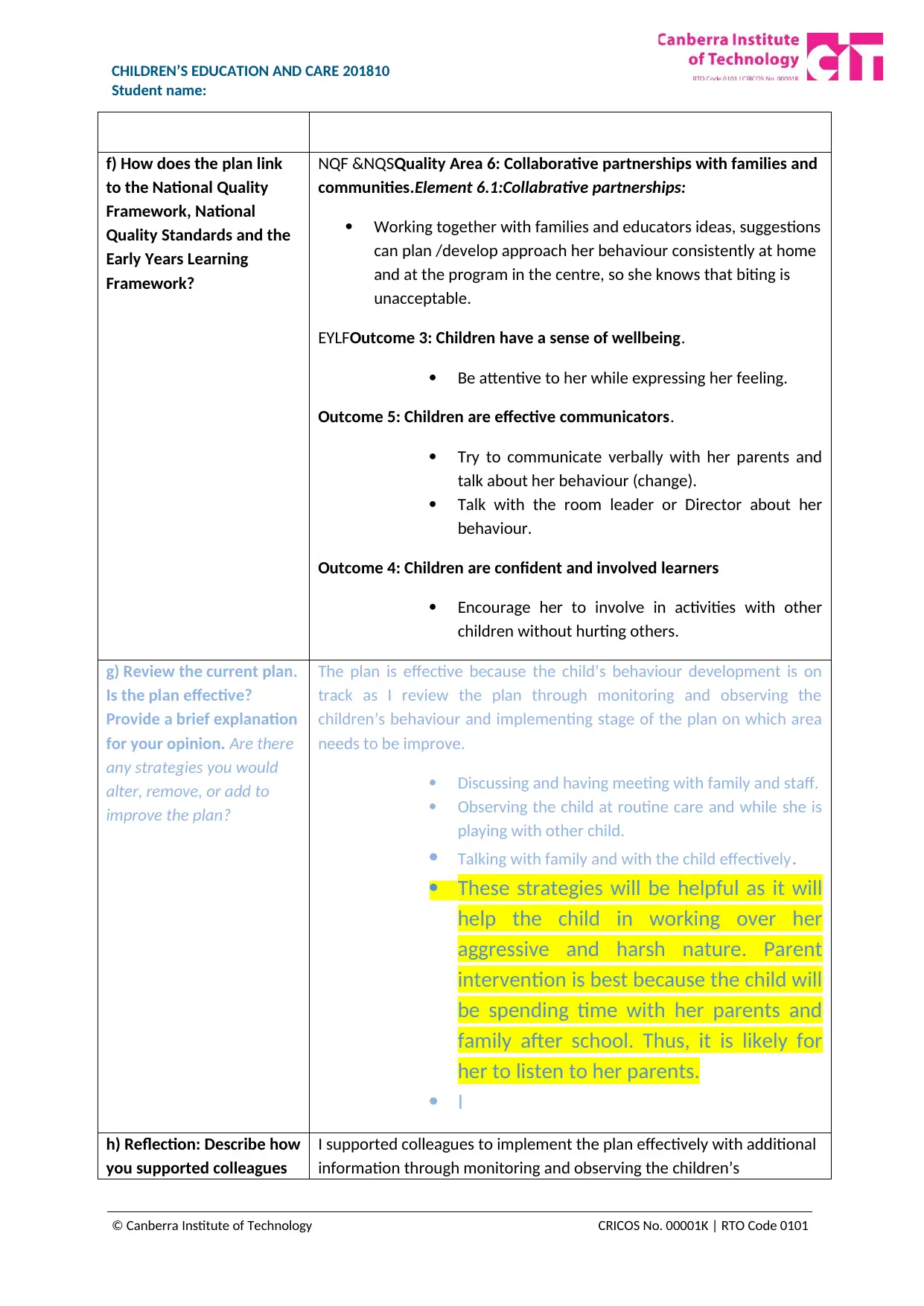
CHILDREN’S EDUCATION AND CARE 201810
Student name:
f) How does the plan link
to the National Quality
Framework, National
Quality Standards and the
Early Years Learning
Framework?
NQF &NQSQuality Area 6: Collaborative partnerships with families and
communities.Element 6.1:Collabrative partnerships:
Working together with families and educators ideas, suggestions
can plan /develop approach her behaviour consistently at home
and at the program in the centre, so she knows that biting is
unacceptable.
EYLFOutcome 3: Children have a sense of wellbeing.
Be attentive to her while expressing her feeling.
Outcome 5: Children are effective communicators.
Try to communicate verbally with her parents and
talk about her behaviour (change).
Talk with the room leader or Director about her
behaviour.
Outcome 4: Children are confident and involved learners
Encourage her to involve in activities with other
children without hurting others.
g) Review the current plan.
Is the plan effective?
Provide a brief explanation
for your opinion. Are there
any strategies you would
alter, remove, or add to
improve the plan?
The plan is effective because the child’s behaviour development is on
track as I review the plan through monitoring and observing the
children’s behaviour and implementing stage of the plan on which area
needs to be improve.
Discussing and having meeting with family and staff.
Observing the child at routine care and while she is
playing with other child.
Talking with family and with the child effectively.
These strategies will be helpful as it will
help the child in working over her
aggressive and harsh nature. Parent
intervention is best because the child will
be spending time with her parents and
family after school. Thus, it is likely for
her to listen to her parents.
I
h) Reflection: Describe how
you supported colleagues
I supported colleagues to implement the plan effectively with additional
information through monitoring and observing the children’s
© Canberra Institute of Technology CRICOS No. 00001K | RTO Code 0101
Student name:
f) How does the plan link
to the National Quality
Framework, National
Quality Standards and the
Early Years Learning
Framework?
NQF &NQSQuality Area 6: Collaborative partnerships with families and
communities.Element 6.1:Collabrative partnerships:
Working together with families and educators ideas, suggestions
can plan /develop approach her behaviour consistently at home
and at the program in the centre, so she knows that biting is
unacceptable.
EYLFOutcome 3: Children have a sense of wellbeing.
Be attentive to her while expressing her feeling.
Outcome 5: Children are effective communicators.
Try to communicate verbally with her parents and
talk about her behaviour (change).
Talk with the room leader or Director about her
behaviour.
Outcome 4: Children are confident and involved learners
Encourage her to involve in activities with other
children without hurting others.
g) Review the current plan.
Is the plan effective?
Provide a brief explanation
for your opinion. Are there
any strategies you would
alter, remove, or add to
improve the plan?
The plan is effective because the child’s behaviour development is on
track as I review the plan through monitoring and observing the
children’s behaviour and implementing stage of the plan on which area
needs to be improve.
Discussing and having meeting with family and staff.
Observing the child at routine care and while she is
playing with other child.
Talking with family and with the child effectively.
These strategies will be helpful as it will
help the child in working over her
aggressive and harsh nature. Parent
intervention is best because the child will
be spending time with her parents and
family after school. Thus, it is likely for
her to listen to her parents.
I
h) Reflection: Describe how
you supported colleagues
I supported colleagues to implement the plan effectively with additional
information through monitoring and observing the children’s
© Canberra Institute of Technology CRICOS No. 00001K | RTO Code 0101
Secure Best Marks with AI Grader
Need help grading? Try our AI Grader for instant feedback on your assignments.
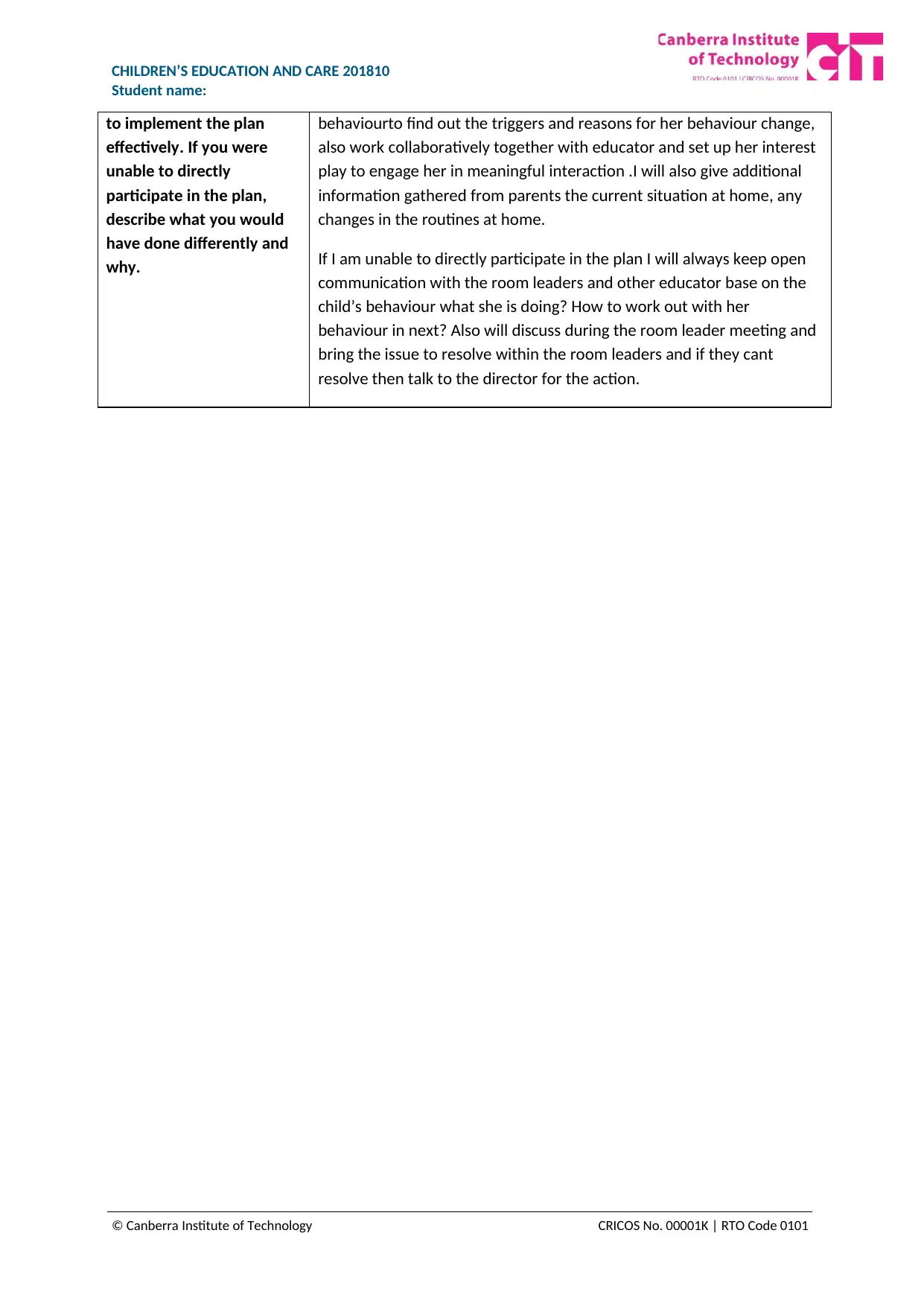
CHILDREN’S EDUCATION AND CARE 201810
Student name:
to implement the plan
effectively. If you were
unable to directly
participate in the plan,
describe what you would
have done differently and
why.
behaviourto find out the triggers and reasons for her behaviour change,
also work collaboratively together with educator and set up her interest
play to engage her in meaningful interaction .I will also give additional
information gathered from parents the current situation at home, any
changes in the routines at home.
If I am unable to directly participate in the plan I will always keep open
communication with the room leaders and other educator base on the
child’s behaviour what she is doing? How to work out with her
behaviour in next? Also will discuss during the room leader meeting and
bring the issue to resolve within the room leaders and if they cant
resolve then talk to the director for the action.
© Canberra Institute of Technology CRICOS No. 00001K | RTO Code 0101
Student name:
to implement the plan
effectively. If you were
unable to directly
participate in the plan,
describe what you would
have done differently and
why.
behaviourto find out the triggers and reasons for her behaviour change,
also work collaboratively together with educator and set up her interest
play to engage her in meaningful interaction .I will also give additional
information gathered from parents the current situation at home, any
changes in the routines at home.
If I am unable to directly participate in the plan I will always keep open
communication with the room leaders and other educator base on the
child’s behaviour what she is doing? How to work out with her
behaviour in next? Also will discuss during the room leader meeting and
bring the issue to resolve within the room leaders and if they cant
resolve then talk to the director for the action.
© Canberra Institute of Technology CRICOS No. 00001K | RTO Code 0101
1 out of 5
Your All-in-One AI-Powered Toolkit for Academic Success.
+13062052269
info@desklib.com
Available 24*7 on WhatsApp / Email
![[object Object]](/_next/static/media/star-bottom.7253800d.svg)
Unlock your academic potential
© 2024 | Zucol Services PVT LTD | All rights reserved.

